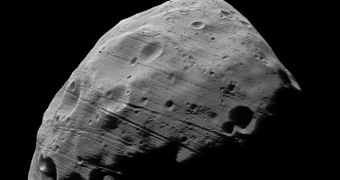Scientists at the European Space Agency (ESA) announce that their space probe Mars Express will be conducting its closest flyby ever around the moon Phobos this Wednesday, March 3. The event is very important, as it will allow astronomers to collect a wealth of completely new data on the Martian moon, which is not very large, but poses a number of very interesting questions. For starters, experts are still unsure as to whether it was produced around the Red Planet from the get-go, or whether it was a space rock wandering through space, which got caught up by the planet's gravitational pull.
The thing that sets the new flyby apart from other similar instances is the fact that Mars Express will skim the surface of Phobos at an altitude of only 67 kilometers, which is very low considering that accurate data can be collected from higher altitudes as well. In fact, engineers and mission planners at ESA wanted to fly the probe even closer, but Mission Control wouldn't allow them to do so, on account of the danger level the spacecraft would be placed in. Astronomers say that, the closest the distance, the more data the probe's precise radio tracking systems will provide on its composition. Other properties will also be surveyed, they add.
Mars Express is currently engaged in an observation campaign of Phobos, as its orbit took it in close proximity to that of the moon. It will perform a total of 12 flybys of the space rock, during which different sets of its instruments will take preeminence in scientific observations. But by far the closest one will take place on Wednesday, at 21:55 CET (20:55 GMT). One of the main traits of the moon that the science team managing the spacecraft will use in their studies is the amount of pull that the rock exerts on the orbiter. They expect the moon to move the spacecraft slightly off-course, by a few millimeters each second, but without any long-lasting impact on the rest of the mission.
“All the experiments on Mars Express have something to say about Phobos,” explains Mars Express project scientist Olivier Witasse. “Because Mars Express is in an elliptical and polar orbit with a maximum distance from Mars of about 10,000 km, we regularly pass Phobos. This represents an excellent opportunity to perform extra science,” he adds. The upcoming flyby could also help geologists figure out the distribution of matter inside Phobos' core, which could help them establish the moon's origins. Many have asked whether the body was formed from Mars, in very much the same way the Moon is believed to have come out of the Earth following a space impact, or the body is simply a meteorite or a comparable structure that was trapped by Mars' gravitational pull and held prisoner ever since.

 14 DAY TRIAL //
14 DAY TRIAL //